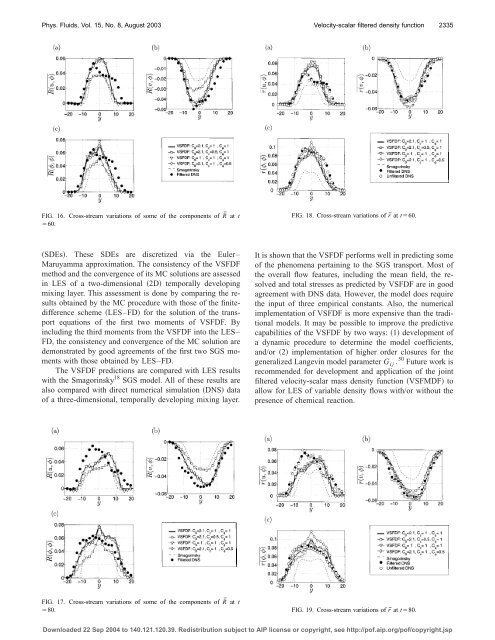Velocity-scalar filtered density function for large eddy simulation of ...
Velocity-scalar filtered density function for large eddy simulation of ...
Velocity-scalar filtered density function for large eddy simulation of ...
Create successful ePaper yourself
Turn your PDF publications into a flip-book with our unique Google optimized e-Paper software.
Phys. Fluids, Vol. 15, No. 8, August 2003<strong>Velocity</strong>-<strong>scalar</strong> <strong>filtered</strong> <strong>density</strong> <strong>function</strong>2335FIG. 16. Cross-stream variations <strong>of</strong> some <strong>of</strong> the components <strong>of</strong> R¯ at t60.FIG. 18. Cross-stream variations <strong>of</strong> r¯ at t60.SDEs. These SDEs are discretized via the Euler–Maruyamma approximation. The consistency <strong>of</strong> the VSFDFmethod and the convergence <strong>of</strong> its MC solutions are assessedin LES <strong>of</strong> a two-dimensional 2D temporally developingmixing layer. This assessment is done by comparing the resultsobtained by the MC procedure with those <strong>of</strong> the finitedifferencescheme LES–FD <strong>for</strong> the solution <strong>of</strong> the transportequations <strong>of</strong> the first two moments <strong>of</strong> VSFDF. Byincluding the third moments from the VSFDF into the LES–FD, the consistency and convergence <strong>of</strong> the MC solution aredemonstrated by good agreements <strong>of</strong> the first two SGS momentswith those obtained by LES–FD.The VSFDF predictions are compared with LES resultswith the Smagorinsky 18 SGS model. All <strong>of</strong> these results arealso compared with direct numerical <strong>simulation</strong> DNS data<strong>of</strong> a three-dimensional, temporally developing mixing layer.It is shown that the VSFDF per<strong>for</strong>ms well in predicting some<strong>of</strong> the phenomena pertaining to the SGS transport. Most <strong>of</strong>the overall flow features, including the mean field, the resolvedand total stresses as predicted by VSFDF are in goodagreement with DNS data. However, the model does requirethe input <strong>of</strong> three empirical constants. Also, the numericalimplementation <strong>of</strong> VSFDF is more expensive than the traditionalmodels. It may be possible to improve the predictivecapabilities <strong>of</strong> the VSFDF by two ways: 1 development <strong>of</strong>a dynamic procedure to determine the model coefficients,and/or 2 implementation <strong>of</strong> higher order closures <strong>for</strong> thegeneralized Langevin model parameter G ij . 50 Future work isrecommended <strong>for</strong> development and application <strong>of</strong> the joint<strong>filtered</strong> velocity-<strong>scalar</strong> mass <strong>density</strong> <strong>function</strong> VSFMDF toallow <strong>for</strong> LES <strong>of</strong> variable <strong>density</strong> flows with/or without thepresence <strong>of</strong> chemical reaction.FIG. 17. Cross-stream variations <strong>of</strong> some <strong>of</strong> the components <strong>of</strong> R¯ at t80.FIG. 19. Cross-stream variations <strong>of</strong> r¯ at t80.Downloaded 22 Sep 2004 to 140.121.120.39. Redistribution subject to AIP license or copyright, see http://p<strong>of</strong>.aip.org/p<strong>of</strong>/copyright.jsp



